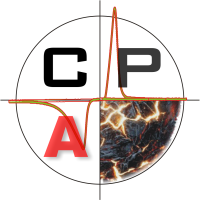
Journal of
Corrosion and Anticorrosion Protection


 Volume IV, Issue 3, 2009
Volume IV, Issue 3, 2009
 Home
Home------------------------------
 About Us
About Us------------------------------
 Authors Guide
Authors Guide------------------------------
 Subscription
Subscription------------------------------
 News
News------------------------------
 Contact Us
Contact UsContent



Horaţiu VERMESAN  , Ernest GRÜNWALD
, Ernest GRÜNWALD  , Elena VERMESAN, Caius BULEA
, Elena VERMESAN, Caius BULEA  , Vasile RUS
, Vasile RUS  .
.
Chronopotentiometric studies of the benzylideneacetone as brightener for zinc electrodeposition from weak-acid electrolytes
Abstract: This study focuses on benzylideneacetone surfactant C10H10O (B.AC) as brightener for zinc electrodeposition from weak-acid baths with various Zn2+ ions concentrations and various brightener amounts added.
Benzylideneacetone is a very effective brightener to form a fine, compact and bright zinc layer.
An original chronopotentiometric study and data processing system was used in this study.
This work shows the results of a chronopotentiometric study with highlights on some aspects regarding the benzylideneacetone influence on electrodeposited zinc layers from diluted weak-acid zinc electrolytes.



Andreea HEGYI  , George VERMESAN
, George VERMESAN  , Horaţiu VERMESAN
, Horaţiu VERMESAN  .
.
Applications of hot-dipped zinc (galvanized) coatings for reinforced concrete structures
Abstract: The durability of civil, industrial and military constructions affects state environmental and can have economical and social consequences.
One of the directions of research in the field of construction is to enlarge the sustainability and reduce environmental impact. The corrosion of reinforced concrete structures is a domain that is studied for a long time with real but unconvincing results because of the complexity of the phenomenology caused by the interaction between the concrete, the reinforcement and the environment. The hot-deep galvanization method of steel used for reinforcing concrete assure a good protection against corrosion and extends the lifetime of structures. Galvanizing of the component elements of the buildings is a good solution for this purpose. The article presents the effects of galvanization, especially in reinforced concrete and steel structures.



D. González MARTIN, V. LUCERO, J.C. Mirza ROSCA
Passivation study of Ti-5Al-4V in artificial saliva
Abstract: The surface films formed on titanium alloy Ti-5Al-4V are investigated in different experimental conditions. One of these conditions is a heat treatment: 24 hours in oven at 500°C, then cooled in water. Another condition is a H2SO4 treatment: the samples are immersed in H2SO4 3M, for 1 minute at 60 volts. The last condition is a NaOH treatment: the samples are immersed in NaOH 10M at 60°C for 24 hours. In order to characterise the surface film formed in each case in artificial saliva, different techniques were applied: optical metallography, ESEM and EDAX, Vickers microhardness, Open circuit potential and Electrochemical Impedance Spectroscopy. The results were correlated and the nature and the structure of the surface film in every experimental condition was analysed..



Adriana VLASA, Simona VARVARA, Liana Maria MURESAN
Corrosion investigation of Zn-TiO2 composite coatings by using electrochemical impedance spectroscopy
Abstract: The corrosion resistance of composite coatings obtained by electrolytic co-deposition of Zn with two types of TiO2 nanoparticles was investigated by using electrochemical impedance spectroscopy (SIE).
The electrodeposition of the Zn-TiO2 nanocomposite films was carried out in an aqueous electrolyte containing 75 g/l ZnCl2, 230 g/l KCl, 20 g/l H3BO3, brightening agents and suspended TiO2 nanoparticles (Alfa Aesar (AA) 99.9%, 32 nm) or Degussa (D) 99.5%, 21 nm) in a concentration of 5 g/l. For corrosion studies, a solution of 0.2 g/l (NH4)2SO4 (pH 3) was used.
It was found that, in the same experimental conditions, TiO2 Degussa confers to the zinc coatings in which is incorporated better corrosion resistance than TiO2 Alfa Aesar. Both composite Zn-TiO2 deposits are more corrosion resistant than pure Zn coatings.



Eva TRIMBITASU, Octav PANTEA, Stelian NEAGOE, Andreea BONDAREV, Sonia MIHAI
Aspects regarding metals corrosion in different electrolites solutions
Abstract: In this paper it is presented a study regarding the variation of the corrosion rate of some metallic materials immersed in electrolyte solutions. It was used the method of losing weight of the metallic samples and after the specimens exposure in corrosive media, these were observed at electronic microscope. The experimental results are presented as tables and graphs.



Eva TRIMBITASU ![]() , Octav PANTEA, Andreea BONDAREV, Sonia MIHAI, Stelian NEAGOE
, Octav PANTEA, Andreea BONDAREV, Sonia MIHAI, Stelian NEAGOE
The urban traffic, a pollution reason in Ploiesti city
Abstract: Soils pollution with heavy metals is mainly influenced by the road traffic intensity. In this paper it was presented a study regarding the soils heavy metals content from intense circulated areas from Ploiesti City. There were drawn soils samples from five places where the traffic is intensely and it was supervised the heavy metals content for five weeks. The determination of heavy metals content was made by the spectrophotometric method after the mineralization of soil samples. The obtained experimental data are presented and graphically correlated.
 Year
Year
|2010||2009|
|2008|
|2007|
|2006|
The Journal of Corrosion and Anticorrosion Protection is edited by S.C. BETAK S.A.
in collaboration with Technical University of Cluj-Napoca, Romania